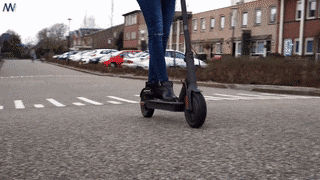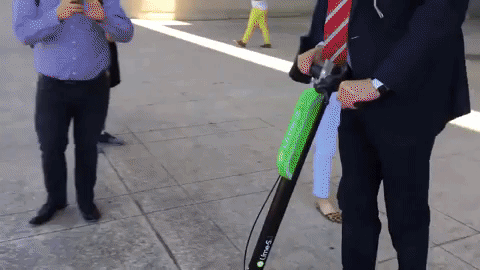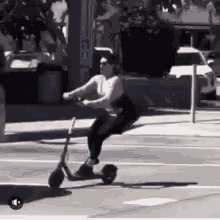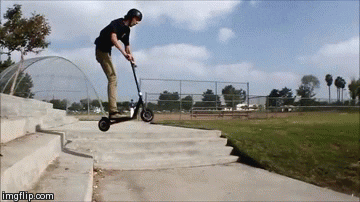Scoot Away
by Kenneth Lyen






INTRODUCTION
Recently, when walking along a pedestrian path near my home, I felt a whoosh of air as an e-scooter brushed right by me. Just a couple of millimeters nearer, I would have been severely laerated or knocked down. Another incident I encountered one year ago was when I was driving home from work. As I was making a left turn, an e-scooter belted right in front of me and I slammed on the brakes, narrowly missing him. These two incidents may have influenced my views on e-scooters.
Already a few countries have banned e-scooters from pavements and roads, including Germany, France and Japan.
DEFINITIONS
Personal mobility devices (PMDs): include electric scooters (e-scooters), kick-scooters, electric unicycles, electric hover boards, skateboards, roller skates and similar devices.

Electric Scooters (E-Scooters): refer to devices with no more than two 25 cm or smaller diameter wheels that have handlebars for steering; they are designed to be stood upon by the operator, and are powered by an electric motor that is capable of propelling the device with or without human propulsion at a speed no more than 30 km/hour on a paved level surface (until the recent ban, Singapore's legal speed limit for footpaths was 10 km/hour).

ARGUMENTS IN FAVOUR OF E-SCOOTERS
1 They help people commute short distances.
2 They can potentially reduce the number of cars on the road and thereby help in the fight against global warming.
3 They can be used for delivery of food and parcels.
4 They can spur cities to build more cycling paths that can be shared with e-scooters.
5 They can stimulate innovations to build better, safer e-scooters with non-exploding batteries.

ARGUMENTS IN FAVOUR OF RESTRICTING PLACES FOR E-SCOOTERS TO BE USED
The major arguments for setting limits to places where e-scooters can be used are based on the following safety concerns:
1. E-scooters can knock down and injure people
Under Singapore’s law, e-scooters are not allowed on roads. The new law extends the ban to footpaths, all 5,500 km of them. The only places left for e-scooters to be used are shared pathways, such as cycling paths and park-connector networks, which consists of just 440 km.
According to the Minister of Transport, Khaw Boon Wan, in 2017 and 2018, there were 228 reported accidents involving PMDs on public paths, 196 of them resulting in injury. One mishap left the victim, 65-year-old Madam Ong Bee Eng, in a coma and she subsequently died in hospital. There were 32 other accidents that resulted in major injuries, such as concussions and fractures.





2. Exploding batteries causing fires
Fires are caused by exploding batteries during recharging of the personal mobility devices, especially e-scooters. In 2016 there were 9 fires, but over the past four years this has increased dramatically to 75 fires in 2018, and in 2019 there were 102 fires. Altogether from 2016-2019 there have been 5 deaths and a few suffering third degree burns.









3. Riders getting injured
Riders themselves can be victims when they are knocked down by other vehicles, or even crashing into one another. Tan Tock Seng Hospital reported that between January 2017 and September 2019, the accident and emergency department treated 213 patients who were PMD riders, of which six patients were pedestrians struck by PMD riders. Of the 213 PMD rider incidents, there were six deaths.



CONCLUSIONS
The incidence of death and injuries from e-scooter related accidents has risen over the past 4 years. It is of paramount importance to protect people from serious harm. The pros and cons for allowing e-scooters to travel along pedestrian footpaths are overwhelmingly in favor of restricting them along these walkways. Yes, we do understand that the majority of e-scooter riders are sensible and obey the law, but it is the outliers who flaunt safety regulations that cause life-threatening consequences. At the moment Singapore is not ready for e-scooters. But in future, if more bicycle paths are built, and other safety measures are incorporated into the e-scooters, perhaps this might argue for reconsidering the current restrictions.
An analysis of 259 personal mobile devices accidents seen at the Khoo Teck Puat Hospital Singapore in 2016 was published in 2020, and concluded that the majority of the injuries suffered were the riders themselves, and most were superficial wounds. Injuries inflicted on pedestrians and pedal cyclists constituted 2.3% of all the patients. Although head and face injuries amounted to less than 1% of all the injuries, there was one death due to an e-scooter colliding with a lorry. No data were given as to how many of the accident victims wore protective helmets or other guards. However, the authors recommend the wearing of protective shields, as well as the separation of motorised mobile devices from pedestrians and pedal cyclists.
POSTSCRIPT
Some 30 food delivery riders expressed their concerns about the ban on the use of e-scooters on footpaths when they met up with Home Affairs and Law Minister K. Shanmugam on Tuesday 5th November. This led to the setting up of $7 million fund to buy back e-scooters from three major food delivery companies: Grab, Deliveroo and FoodPanda. Food delivery owners from these companies can trade in their existing e-scooters until 31 December 2019 for up to $1,000 to buy a power-assisted bicycle, or $600 to buy a personal mobility aid. Those food-delivery owners of e-scooters unable to transition to other personal mobility devices were upset because they lost a source of income.
Below are photographs of people lining up to dispose of their e-scooter and get a government subsidy to buy an alternative personal mobility device.








REFERENCES
INJURIES
National Trauma Registry: https://bmcpublichealth.biomedcentral.com/articles/10.1186/s12889-019-7210-6
Tan Tock Seng Hosp: http://www.annals.edu.sg/pdf/48VolNo4Apr2019/V48N4p125.pdf
FIRES
E-scooter fires increased 300% https://www.todayonline.com/singapore/e-scooter-fires-soar-300-2017-even-fire-cases-hit-40-year-low-scdf
E-scooter bursts into flames: https://www.youtube.com/watch?v=T-j2S99jVEY
PMD-related fires in 2019:
https://www.channelnewsasia.com/news/singapore/scdf-pmd-fires-e-scooters-injured-12425962
FUND TO HELP DELIVERY RIDERS
RESEARCH
Injury patterns associated with personal mobility devices and electric bicycles in Singapore.
http://www.smj.org.sg/sites/default/files/SMJ-61-96.pdf
Written by Kenneth Lyen
5 November 2019, Revised 27 April 2020
%20a.jpg)


